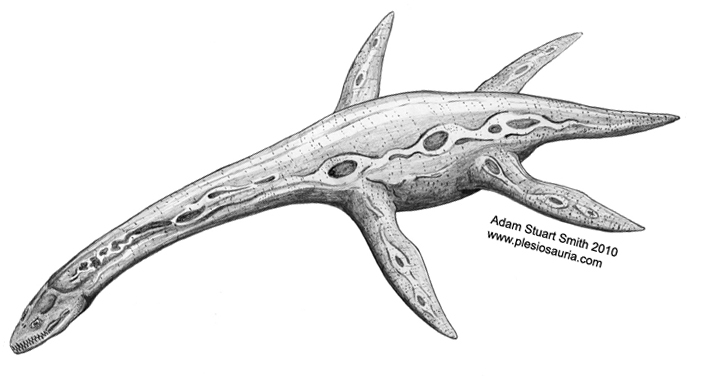The name game: Plesiosaur-ia, -oidea, -idae, or -us?
Proper taxonomic names, with formal suffixes, can be confusing at the best of times. But when they include identical prefixes their meaning can be further complicated. For example, to what taxonomic group does the colloquial term ‘plesiosaur’ refer: Plesiosauria, Plesiosauroidea, Plesiosauridae, or Plesiosaurus? With all these similar sounding names it is not surprising that laypersons and specialists alike may have different concepts of what a ‘plesiosaur’ actually is.

To understand the colloquial terminology we must first clarify the scientific terminology – those suffixes have discrete meanings after all. I’ll start off by explaining each name in order from the lowest ranked to the highest ranked. A taxon (or taxonomic group) of low rank is very specific (e.g. a species) whereas a taxon of higher rank is broader (e.g. an order). Apologies in advance, I realise that this might get a bit technical and dry…
Scientific terminology
Plesiosaurus. This refers to the genus Plesiosaurus. In this case the suffix ‘-us’ is of no significance. Generic names are always italicised.
Plesiosauridae. This refers to the family that includes Plesiosaurus. Animal families strictly end with the suffix ‘-idae’. The term Plesiosauridae isn’t used much these days because most species previously placed within the Plesiosauridae have since been referred to the Elasmosauridae. This has left Plesiosaurus as the only taxon in the family, making the family name more or less redundant. [EDIT – A recent analysis by Ketchum and Benson (2010) has proposed a new and more inclusive definition for Plesiosauridae, which I strongly endorse.]
Plesiosauroidea. This refers to the superfamily that includes Plesiosauridae, Elasmosauridae, Cryptoclididae, and others. Animal superfamilies strictly end with the suffix ‘-oidea’. The second (and only) other superfamily of note here is the Pliosauroidea.
Plesiosauria. This refers to the higher taxon that includes the superfamilies Plesiosauroidea and Pliosauroidea. It is usually regarded as an Order today, but its rank has varied historically. Orders often end with the suffix ‘-ia’, but the strict use of suffixes is not applied beyond the taxonomic level of Superfamily.
These taxa are nested within each other as follows: Plesiosaurus belongs to the Plesiosauridae, which belongs to the Plesiosauroidea, which belongs to the Plesiosauria.
Colloquial terminology
There is a standard colloquial terminology for some of these scientific names: Plesiosaurus is the same, while Plesiosauridae is plesiosaurid. (Notice that the colloqial names are all lower case whereas the scientific names start with a capital letter). From here things get complicated because, as far as the published literature goes, there is no standard colloquial terminology for Plesiosauroidea and Plesiosauria: both are frequently referred to as ‘plesiosaurs’. There are therefore two meanings for the word ‘plesiosaur’:
Plesiosaur meaning 1. The word ‘plesiosaur’ is often used to refer to Plesiosauria, the largest most inclusive taxon, with pliosauroids (or pliosaurs) included. In this case, the symmetrical terms plesiosauroid and pliosauroid can be used colloquially to distinguish between the superfamilies Plesiosauroidea and Pliosauroidea. The word pliosaur works well for the Pliosauroidea too here, although it is not symmetrical in this case (note that there is no such group as Pliosauria). I almost always use the word plesiosaur in this way, as evident in the title of my website (the Plesiosaur Directory) and this blog (Plesiosaur Bites). I don’t discriminate against pliosaurs… remember, pliosaurs are plesiosaurs too! Or are they?
Plesiosaur meaning 2. The word ‘plesiosaur’ is also often used to refer to the Plesiosauroidea. This colloquial meaning is commonly adopted, particularly in books and websites, because it sorts these critters into two manageable groups: plesiosaurs and pliosaurs. This makes sense because it is symmetrical (note that there is no such group as Pliosauria, so meaning 1 for the word ‘plesiosaur’ can’t be symmetrical in the same way.)
To avoid ambiguity, the colloquial term plesiosaurian (with an extra ‘n’) can be applied to the Plesiosauria, which would seem to tie everything up neatly. I have started to do this in my technical papers. Maybe I should change the title of my website to ‘The Plesiosaurian Directory’?
To summarise, we have two competing colloquial meanings for the word plesiosaur and I’m not entirely convinced one is better than the other. To avoid ambiguity in the technical literature, I and other researchers have started to avoid using the word plesiosaur entirely, favouring instead the words plesiosaurian (for the Plesiosauria) and plesiosauroid (for the Plesiosauroidea). I’m probably making a mountain out of a molehill but I think this is a topic that could do with further discussion. How do you use the word plesiosaur? Which to you prefer? Comments are very welcome!

I have a question: What is the convention of naming those families – why was the family of Elasmosauridae called Elasmosauridae, and not Brancasauridae, for instance? Is it because Elasmosaurus was the first species of this group described scientifically, or is it because Elasmosaurus has the highest number of individuals found, or is it something else?
The convention is for families to be named after a ‘type’ genus within that clade. The type of a family is usually the first one that was named. This only applies at family level, so higher ranked clades do not have type genera. Hence, family names are all boring, while higher taxonomic names can be more original (e.g. Xenopsaria).